Are you a beginner woodworker looking to create something special? Woodworking is an art, and the key to mastering it lies in the tools. You may have heard of the traditional saws, drills, and sanders, but what about specialty woodworking tools? These essential pieces of equipment will help you craft unique projects with precision and finesse. Consider them your paintbrush as you bring your visions to life.
From jigsaws that allow you to make intricate cuts to lathes for creating curved shapes, these specialty tools can take your woodworking from good to great.
In this article, we’ll explore the must-have items for any aspiring woodworker’s toolbox. Let’s get started!
Key Takeaways
- Jigsaws, table saws, routers, and drills are essential specialty woodworking tools for beginners.
- These tools offer precision and finesse in woodworking projects and allow for curved cuts, accurate straight cuts, shaping and finishing wood, and making precise holes.
- Safety precautions, regular maintenance, and proper care are important when using these tools.
- Choosing the right type of tool based on the project requirements and considering features like power, speed settings, and accessories can enhance the woodworking experience for beginners.
Table Saw

The table saw is a must-have for any woodworker, it’ll make your projects so much easier and more efficient! It’s great for making straight, accurate cuts through different types of wood.
The size and shape of the saw blades will depend on the type of project you’re working on, as well as the thickness and hardness of the wood. For example, if you’re working with hardwoods like oak or walnut, you’ll need to use a larger blade with more teeth. If you’re cutting softer woods such as pine or cedar, then a smaller blade with fewer teeth should suffice.
The table saw also allows you to make angled cuts at various degrees. This means that not only can you cut straight lines but also curved ones too, allowing for even greater accuracy when crafting items from wood. Additionally, many table saws come equipped with additional features such as adjustable fences that allow for increased rip capacity and dust collection systems which help keep your work area clean while working on projects.
When it comes to safety, using a table saw requires extra caution due to its sharp blades and powerful motor. Safety guards should always be used to protect yourself from potential injury or harm from flying debris when cutting through materials.
With all these features combined, it’s no wonder why a table saw is an essential tool for any beginner woodworker! And with careful handling and practice over time, this powerful machine will soon become one of the most trusted tools in your workshop.
Using a jigsaw allows novice woodworkers to create intricate designs in their workpieces without having mastered advanced skills like those needed on the table saw…
Jigsaw

A jigsaw’s a must for any DIY-er; it’ll cut curves with ease. It’s versatile and small, making it great for tight spaces or intricate jobs. But before you get started, there are a few things to consider:
- Jigsaw Benefits: With the right blade and speed setting, a jigsaw can handle everything from basic cuts in softwood to intricate patterns in hardwood and metals. Plus, they’re easier to control than other saws like the table saw.
- Jigsaw Hazards: Dust collection is an issue with a jigsaw so be sure to use dust masks and goggles while working as well as ensure your workspace is well ventilated.
- Safety Features: Look for features like orbital action (controls how aggressively the blade moves back and forth) or variable speed settings that help you make the perfect cut every time without overdoing it on power or speed.
- Comfortability: Invest in an ergonomic model that comes with adjustable handles so you can work comfortably no matter what size project you’re tackling.
Essential safety precautions aside, a jigsaw will give beginners much-needed precision when tackling projects like cutting out circles or creating curved edges quickly and accurately thanks to its wide range of blades available for different materials types and thicknesses, something most other saws simply can’t do as easily or safely! And since they don’t require large tables or stands for support, they can be used almost anywhere too! Ready to take your woodworking skills up a notch? Consider adding a router next!
Router
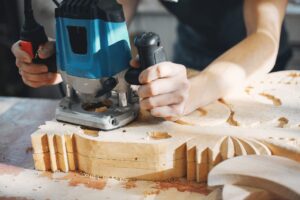
You’ll love the versatility that a router brings to your DIY projects! A router is an essential tool for woodworking, allowing you to shape and finish pieces of wood with precision. With its adjustable speed settings, a router can be used for everything from making simple grooves and edges to complex designs. It’s also great for creating intricate shapes or patterns in wood. Plus, it’s capable of producing extremely fine finishes on your pieces.
With the right shaping techniques and wood finishing products, you can create professional-looking results with minimal effort, perfect for those just starting in woodworking!
A router makes it easy to make cuts in tight spots where other tools may not fit, such as along edges or inside corners. Its ability to produce smooth curves helps add character and interest to any project. And because they come in various sizes and styles, you can find one that fits your needs perfectly. Whether you’re looking for something basic or something more advanced, there are routers available to fit any budget.
When choosing a router, consider what type of projects you plan on doing most often; this will help determine which features are best suited for your needs. Also, look at how much power the machine has; some have more powerful motors than others do. Finally, consider if the router has multiple speed settings, this allows you greater control over how quickly or slowly it moves through a piece of material when cutting or shaping it.
By taking these factors into account before investing in a router, you’ll be sure to get the perfect tool for all your future projects!
As with any power tool, safety should always be a top priority when using a router; read through the manufacturer’s instructions carefully before operating one, and remember to wear protective eyewear while working with it. With proper use and care of your new equipment.
plus experimenting with different shaping techniques and wood finishes.
you’ll soon be well on your way toward achieving beautiful results from all of your future crafting endeavors!
Moving onto drilling…
Drill

With its adjustable speed and power settings, a drill is perfect for making precise holes in a variety of materials. Whether you’re working with hardwood, softwood, or even metal, the right drill will allow you to customize your drilling technique to meet the needs of your project.
For woodworking projects, be sure to consider the type and thickness of the wood when selecting a drill bit, and make sure it’s compatible with the material you’re working on. Additionally, depending on how much detail work you plan to do on your project, having multiple drills can be very helpful; some drills have added features like countersinks that enable more detailed finishing techniques.
Drills also come in many sizes and speeds, from smaller handheld units up to large table-mounted options that provide more control over your work. Regardless of which size you choose, it’s important to select one with enough torque so it won’t get stuck while drilling through harder materials.
Finally, always consider safety first when using a drill, and wear protective goggles and gloves when operating any tool to minimize potential harm from flying debris or sparks.
To ensure accuracy when using a drill for woodworking projects, take your time and use steady pressure throughout the entire operation; that’ll help prevent splintering and give your finished pieces an overall better look once complete.
With these tips in mind, adding a drill to your list of essential specialty woodworking tools should be easy! Next up: band saws – key tools for cutting straight lines into thicker pieces of wood quickly and easily.
Band Saw
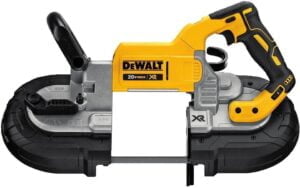
Experience the easy precision of cutting straight lines with a band saw, it’s a must-have for any serious project. Band saws are essential woodworking tools for beginners because they provide precise cuts and can be used to create intricate shapes and curves. They also work quickly. However, like any power tool, safety is paramount when using a band saw. Before operating the machine, make sure you read all safety instructions that come with it. It’s also important to wear protective clothing such as goggles and gloves.
The band saw should always be inspected before use to ensure all parts are working properly and that there aren’t any damaged or loose blades that could cause harm. Regular maintenance is key too. Keep the blade clean and sharpened, the table free from dirt build-up, and oil moving parts frequently to prevent rusting or sticking. With proper care, your band saw will last many years and help you craft beautiful pieces of furniture or artwork!
Understanding how to safely use a band saw will take time, but by taking the necessary precautions, you can experience its benefits right away without compromising on safety.
Transitioning into the next section about planers: To further enhance your projects’ edges, consider investing in a planer, it’ll give them an even smoother finish than what a band saw alone can offer!
Planer
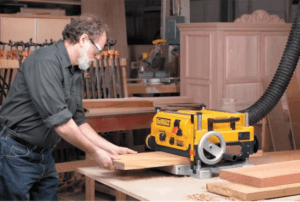
A planer is a great way to give your projects the modern, polished look they deserve. With its ability to quickly and accurately plane down wood surfaces, it’s the perfect tool for giving you those crisp edges and smooth surfaces that’ll make your work stand out from the crowd. Plus, the fact that it’s super easy to use makes it a must-have for any DIYer looking to take their craftsmanship up a notch!
To get started with using a planer, there are several steps involved:
- Setting up: Make sure all screws are tightened properly and that everything is securely in place before beginning.
- Sharpening blades: Sharpen or replace dull blades before getting into any project. This will ensure cleaner cuts and better results overall.
- Adjusting depth of cut: Adjustable depth of cut allows you to change how much material is removed with each pass on the board.
- Feed speed: To prevent tear-out or chipping, adjust feed speed so that it matches the thickness of the board being cut.
- Dust collection: Using dust collection systems improves visibility while working and reduces cleanup time after completing a job.
Planers can be used on both softwoods and hardwoods alike, allowing you to easily create intricate designs with minimal effort. And because they’re versatile enough to handle curved pieces as well as straight boards, you can explore more complex designs without having to worry about making mistakes in the process!
Whether you’re just starting in woodworking or have been doing it for years, having a planer in your arsenal will help take your projects up another level of quality and precision! From setting up to sharpening blades, this essential specialty tool has got you covered every step of the way!
Moving onto Sanders…
Sander
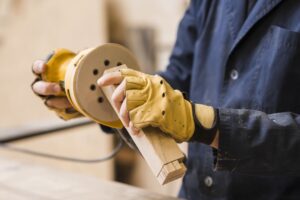
Once you have your planed surfaces, it’s time to move on to sanding. Sanding is a critical step in the woodworking process that will help you achieve smooth edges and surfaces. A sander is an invaluable tool for beginners; even if you don’t think you need one, it can make your projects look much more professional with minimal effort.
A sander operates by using an abrasive material to scrape away tiny particles of wood from the surface of the project. Depending on what type of sander you use, there are a variety of techniques for sanding different types of surfaces and materials. Handheld sanders with rotary heads are great for small projects like cabinets or furniture, while belt sanders work best on larger pieces such as tabletops or floors.
It’s important to choose the right grade of sandpaper for your project, too coarse and will leave scratches, while too fine won’t remove enough material from the surface. Generally speaking, start with a course grit and then work up to finer grits until your project is perfectly smooth. When switching between grades, be sure to clean off any dust residue between steps with a brush or vacuum cleaner before moving on to the next grade.
When choosing which type of sander is right for your project, consider both functionality and cost-effectiveness, some machines may offer more features but may be pricier than others. With practice (and patience!), learning proper technique when using a sander can save time and money in the long run by producing better results faster than manual methods alone would allow.
Sanding can seem daunting at first since mistakes can be costly; however, done properly it can give your finished product a professional look that cannot be achieved without this essential tool! To get started on perfecting your craftsmanship skills quickly and efficiently, invest in quality tools that will last so you don’t have to worry about replacing them down the road due to wear-and-tear or damage caused by improper technique usage.
With these tips in mind, now let’s take a deeper dive into another specialty woodworking tool: compound miter saws!
Compound Miter Saw
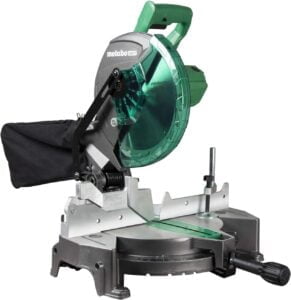
If you’re looking for a tool to help you make precise, accurate cuts, a compound miter saw is the perfect choice! This versatile woodworking tool can handle both small and large projects with ease. It has adjustable blades that rotate in two directions for greater accuracy when making angled cuts. The saw also features an adjustable fence for making perfectly straight cuts. Plus, it’s relatively lightweight and easy to maneuver around the shop or job site.
Safety should always be top of mind when using any power tools like a compound miter saw. Always wear protective eye gear and hearing protection when operating the saw. Additionally, ensure that your workspace is free of debris before turning on the machine. Regular maintenance will help keep your miter saw working at its best, remember to lubricate moving parts regularly and clean out any buildup of dust or wood chips from the blade area after each use.
In addition to safety and maintenance, certain accessories can improve accuracy and enhance your work on the compound miter saw. Clamps are essential for keeping pieces firmly in place while cutting; they come in all shapes and sizes depending on what type of material you’re working with. A laser guide attachment will help make sure that your cuts are perfectly straight every time. Investing in these accessories is smart if you plan to do a lot of work with this tool over time as it’ll give you better results quickly and easily!
A compound miter saw is an invaluable tool for precision woodworking projects, from simple furniture repairs to intricate trim work designs, but only if used properly! Taking proper steps towards safety as well as investing in additional accessories can take your skills up a notch, so get ready for some serious crafting success!
Chisel

Chisels are versatile tools, capable of creating intricate details in woodworking projects. They can be used for tasks such as grooving, cutting, chamfering, and trimming. In addition to these basic uses, they can also be employed to suit more specialized purposes such as wood carving and chisel sharpening.
Chisels come in a variety of shapes and sizes; some of the most common are flat chisels, corner chisels, skew-edged chisels, and mortising chisels. These various shapes allow users to create different types of cuts and grooves depending on their specific needs.
When using a chisel, it’s important to ensure that it’s properly maintained since its edge dulls quickly with frequent use over time. This involves ensuring that the blade remains sharp by regularly honing it using a whetstone or diamond stone and sharpening the blade with finer abrasives when necessary. It’s also important to use the right grip for maximum control so that you don’t slip while working on delicate areas.
In terms of safety measures when using a chisel, there are some key points to keep in mind. These include wearing protective gloves and eye protection while working with these tools, as well as keeping them away from children at all times due to their sharp blades, which could cause serious injury if mishandled or misused. As long as these safety precautions are taken into account, along with proper maintenance techniques, then anyone can enjoy woodworking with this essential tool without any worries!
With that said, let’s move on to lathes, another essential specialty woodworking tool for beginners!
Lathe
Using a lathe is an essential part of any woodworker’s toolkit. There are many types of lathes available, ranging from small benchtop models to large industrial machines. Operating a lathe can be intimidating at first, but with practice and patience, you’ll soon be able to make beautiful and accurate pieces with ease.
Types of Lathes
You’ll need a lathe to turn wood into smooth, precisely shaped pieces. Lathes come in two main types: spindle and faceplate.
Spindle-type lathes are best for most beginner woodworking projects, as they allow you to quickly turn cylindrical shapes with ease. The other type of lathe is the faceplate, which allows you to create more complex shapes such as bowls and dishes.
Before operating your lathe, it’s important to take safety precautions and set up your workbench correctly. Make sure you have the right tools on hand before beginning any project and wear protective gear when using your lathe.
With these essentials in place, you’re ready to craft beautiful items with your new tool! Moving on to operating a lathe, let’s talk about what that entails.
Operating a Lathe
Before you start operating a lathe, it’s important to familiarize yourself with the basics so you can create precise and beautiful pieces.
Woodturning is an art form that requires attention to detail and skillful technique. With the right tools, accessories, and techniques, you can turn wood into stunning works of art.
To get started, make sure your lathe is properly secured and the speed settings are correct for what you’re working on. Then, select your woodturning accessories according to the type of project you plan to do. These may include gouges, chisels, parting tools, or scrapers.
Use practice pieces to hone your skills before doing any intricate work on real pieces of wood. With proper safety precautions in place and some practice under your belt, you’ll be ready to start creating beautiful works of art with confidence!
Conclusion
You have all the tools you need to begin your journey in woodworking!
With a table saw, jigsaw, router, drill, band saw, sander, compound miter saw, and chisel in hand, you can start crafting unique masterpieces.
Consider woodworking as a voyage with each tool being like the stars guiding you through uncharted waters. When it comes time for detailed work or delicate shapes and sizes, then turn to your lathe as it’ll be your compass on this journey. So get ready to embark on an exciting journey of creativity and craftsmanship with these essential specialty woodworking tools!
Frequently Asked Questions
How much should I expect to spend on specialty woodworking tools?
It’s a balancing act, tool selection, and budgeting costs. Consider what you need to get the job done without breaking the bank. Invest in quality tools that will last, but don’t go overboard. Shop around for the best prices to make sure your money is well-spent.
What safety precautions should I take when using these tools?
When working with woodworking tools, store them properly and always wear protective attire. Make sure all blades are sharp and that you have the right clothing such as goggles, gloves, apron, etc. Keep your work area clean and avoid distractions for maximum safety.
Are specialty woodworking tools difficult to operate?
Operating specialty woodworking tools isn’t difficult, but it does require proper tool selection and maintenance. Keeping your tools in good condition will ensure they’re easy to use and provide consistent results.
Are there any special tips or tricks for using specialty woodworking tools?
You should always be careful when selecting and using specialty woodworking tools. Make sure to maintain them properly for optimal use. With a little practice, you’ll soon become an expert! So don’t be afraid to get creative, it’s worth the effort!
What are the best online resources for learning more about specialty woodworking tools?
You can find great online resources for learning more about specialty woodworking tools. Check out websites that offer tool selection and comparison guides, as well as tips on how to use them. Get the best advice from experts and start your woodworking journey with confidence!

